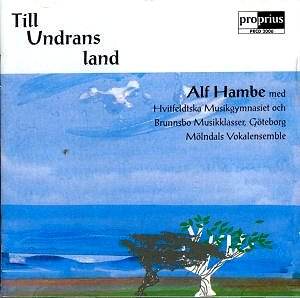How
to place this music. It is not conventionally classical. It certainly
is not avant-garde although it has its Ligetian gurglings and
complexity in Glöm Ström II. It breathes the
air of folk song but has a professional sheen. There is occasionally
a Breton-Celtic curve to the melodies and treatment. The currency
of the songs is love, innocence and landscape. Impressions flood
in: Pete Seeger, Johnny Dankworth, Rita Connolly, Peter, Paul
and Mary, Jake Thackray, Stanford's Bluebird, Swingle II ... The
music carries contentment with a tinge of melancholy, sleepy and
lively. Hambe (who looks to have been in his late fifties when
this CD was issued in 2000) is the vocalist, not professional
singer, in all but one of the tracks. His style is that of sincere
troubadour and the flavour of his voice is fresh but with a hint
of blue smoke and rough grain in the larynx accentuated by close
microphone configuration. He is knowing but not worldweary - not
a Brel or Brassens. He is not afraid of singing unaccompanied
as in Här är den vita staden. The songs are sung
by the composer and by various choirs of adults and of children.
When the choirs participate they sing in unison. This is presumably
down to Martin Bagge's decisions with Hambe. Unison is abandoned
in the haunting complexities of Trädet. Hambe occasionally
kicks over the folkish traces as in the calypso of Himlasprång.
Jazz also plays a part as it does in the choral writing of fellow
Swedes Lindberg and Johanson. It is at its most prominent in the
Johnny Dankworth style of Mellan regn och sol. Hambe’s
writing sometimes overlaps with that of the late Carey Blyton
and Geoffrey Bush in music for young people. Indeed one of the
earliest and most successful practitioners, Joseph Horowitz, wrote
Captain Noah and His Floating Zoo with music sometimes
not far distant from that of Hambe. The instrumental ensemble
is used with restraint, touching in colours and tones rather than
painting in broad swathes. The guitar is a common presence but
listen also for the harp contributing to the simple innocence
of the carol Ros i sno (tr.16).
The
notes and words are in Swedish only as is the case with Proprius
CDs. There is however an introductory essay in English on Hambe
from William Jewson.
Hambe
the troubadour with his freshly blooming folk-based music deserves
a stage well beyond his native Sweden. This CD should help secure
that but requires persistence from non-Swedish speakers.
Rob
Barnett
